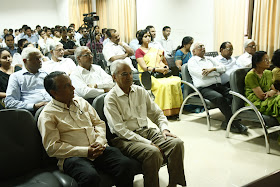The second lecture of lecture series ‘Transcending the Obvious: Explorations of Contemporary India’ organized by Institute of Professional Studies, University of Allahabad was by eminent scientist and Ex-Vice Chancellor of University of Allahabad Prof G.K Mehta.
The programme started by welcome words by Prof. G.K Rai, Director, Institute of Professional Studies , University of Allahabad
The second lecture was on ‘Science, Technology and Applications for Societal Developments.The Role of Particle Accelerators : Past, Present & Future’.
Abstract of Lecture by Prof G.K Mehta
‘Science, Technology and Applications for Societal Developments
The Role of Particle Accelerators: Past, Present & Future’
In late sixties low energy accelerators were being used for basic nuclear physics studies. It was found that Proton Induced X-Ray emission (PIXE) provides a powerful technique for multi-elemental analysis, which led to novel routes in Environmental pollution studies , Forensic Science, Medical diagnosis, Geological prospecting etc. This was early seventies, now with micron size beams, micro-PIXE is providing a way for doing trace element analysis of individual cells to find correlations of diseases with elemental deficiencies.
Role of accelerators in characterizing the samples through other techniques such as Rutherford Back-Scattering [RBS], Elastic Recoil Detection Analysis [ERDA] etc. emerged as extremely important but first there was concern that the nuclear particles will damage the material being studied. Gradually it was realized that the material is not damaged, its properties are changed/modified and if one understands the science of the interaction of ions with materials one can engineer the properties of the materials as per requirement.
By the study with accelerated nuclei using targets made of different types of materials it was found that one can produce new types of nuclei and in some cases generate energy. Now we know that heavy nuclei emit energy if they are made to fission to form lighter nuclei - the Nuclear Fission. And light nuclei can be made to fuse to each other and in the process generates energy –Nuclear Fusion, which is the source of solar energy. These are being used to solve world’s energy crisis, but there is serious concern about the nuclear accidents. Accelerators are now providing a way to create accident free nuclear plants by making Accelerator Based Energy Source (ABES).
Accelerators, besides their role in basic nuclear, atomic and elementary particle physics, invariably open up new perspectives in various fields. It started with the ion implantation for electronic circuits leading to the integrated circuits and developments in ion beam technologies continue to provide the solutions for the bottlenecks in the path of miniaturization of electronic systems. It has been possible to increase the density of transistors on the integrated circuits because of constant improvement in the technology, particularly in beam focusing in the accelerators. Presently Focused Ion Beams of the order of a few nm are available, which are being exploited to increase the component density on the integrated circuits. Experiments with nano-sized ion-beams are clearly indicating the presence of quantum effects which will need new design concepts for the transistors.
Phenomenal developments in ion beam technology is providing an arena that gives an impression that nothing is impossible as long as the aim is clear and the associated science is appropriately explored. Now with the nano world made approachable with the accelerators providing nano- beams we are witnessing achievements such as synthesizing, modifying and engineering the materials at the nano level. It is possible to make nano-composite materials to take up the emerging challenges of fabricating materials such as (1)Intelligent Glass - material which permits light but not heat (2) Material having negative refractive index to provide a way to make real object invisible. We have heard stories from our epics of an “invisible man”, well it may be real. (3) How to make material which can enable us to utilize the thermal energy in the car exhaust etc.
Accelerated beams of charged particles (Ions) continue to open new frontiers for both fundamental and applied research in the sciences, and also in many technical and industrial fields. It is estimated that there are ~ 30,000 accelerators worldwide. Of these, only about 5% are research machines and these are mostly used for low energy research in multidisciplinary areas. Large number of low energy accelerators are used for electronics and industrial processing. Accelerators providing various types of ions with different characteristics and variable energies are providing excellent methods for medical-therapy.
The particle accelerators are in operation around the world, serving medicine, industry, energy, the environment, national security, and discovering new science. As accelerator science and technology continue to advance, so too will their benefits to society.
After the lecture Prof. Mehta answered several questions asked by the audience. Vote of thanks was delivered by Prof. V.C Pandey.
Prateek Pathak & Richa Tiwari
Students
B.A in Media Studies
University of Allahabad
Students
B.A in Media Studies
University of Allahabad














No comments:
Post a Comment